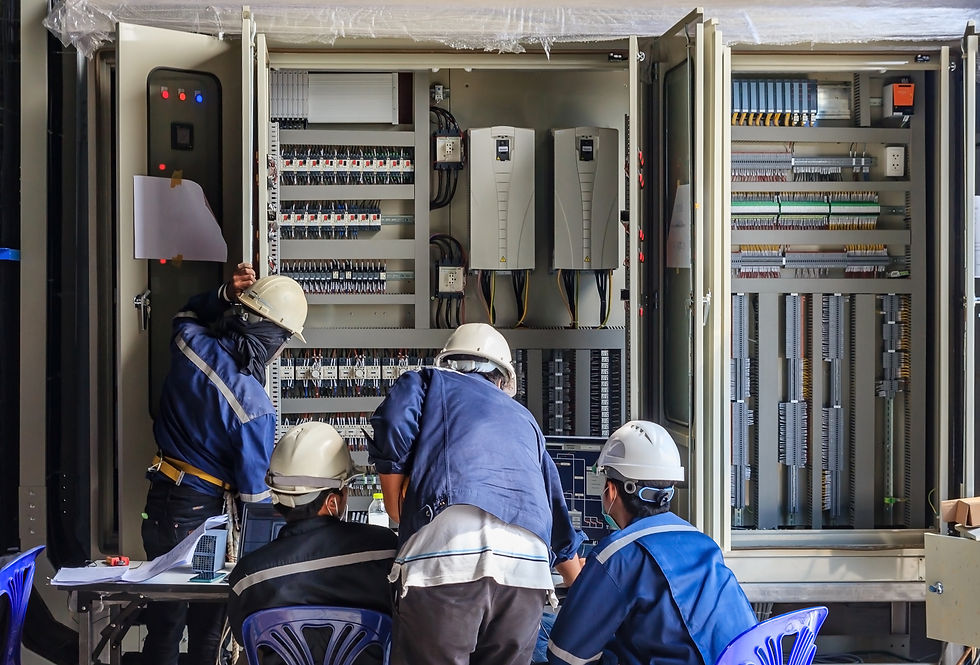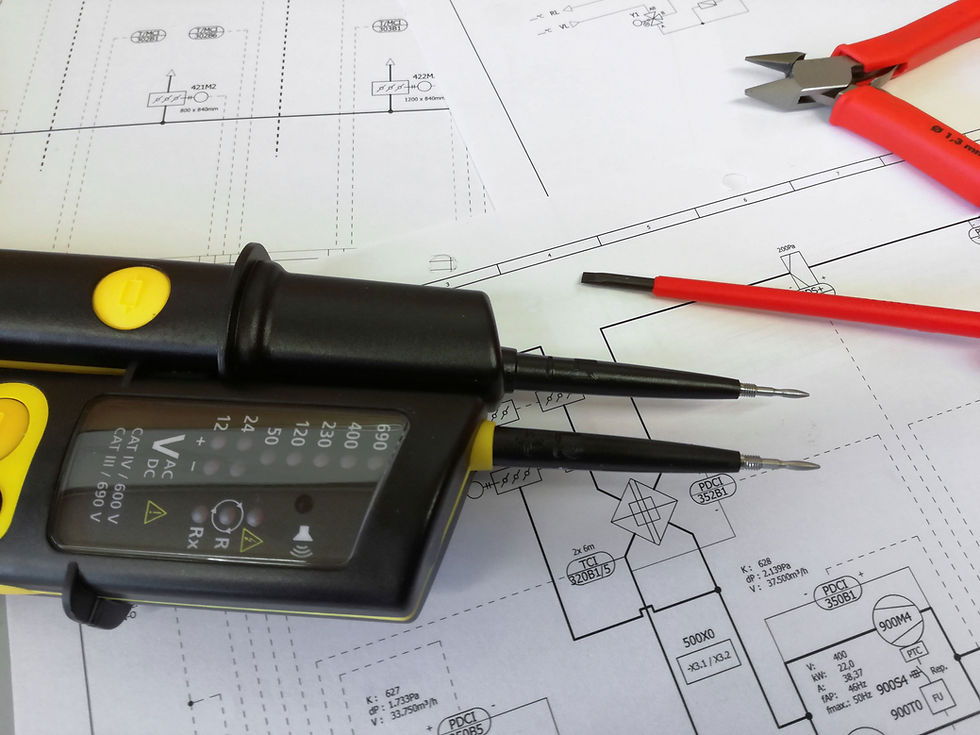Rethinking Responsibility: How AS/NZS 61439 is Quietly Changing Compliance Risk
- IHEA Membership

- 12 minutes ago
- 5 min read
Wil Davies. Undergraduate Electrical Engineer, Alight Consultants
Introduction: The Hidden Shift in Accountability
Most people in healthcare infrastructure understand the importance of switchboard compliance and switchboard integrity, given the critical nature of the systems they support. But few understand the quiet shift in responsibility that can take place under Australia’s updated standards framework.
Imagine this: as a hospital expands, an electrician is called to install new loads to accommodate additional infrastructure. The job is routine—connecting to a spare on a pre-verified switchboard. But under AS/NZS 61439, this seemingly minor task could legally reassign them as the “original manufacturer”—making them responsible for re-verifying the entire assembly against the standard’s full suite of performance criteria. Most in the field are unaware of this obligation, and even fewer are equipped with the documentation or authority to fulfil it.

This is the reality under AS/NZS 61439, the standard that formally replaced AS/NZS 3439 in May 2021. Its goal is to improve safety and traceability in low-voltage switchgear and controlgear assemblies. But in doing so, it introduces new definitions, new documentation expectations, and a significant shift in legal accountability across the assembly ecosystem.
My Honours research explores this shift—not just from a technical perspective, but from a people-centred one. Through interviews with original manufacturers, switchboard assemblers, and electrical contractors, I investigate how compliance responsibility is being transferred, what gaps exist in awareness and support, and what simple interventions could help close the compliance gap—particularly in critical sectors like healthcare.
About Me: From Aviation to Engineering
My path into electrical engineering wasn’t entirely linear. I began with a clear dream: to become a pilot. That ambition led me to study Aviation at Griffith University, where I paired it with Electronic Engineering to gain a deeper understanding of the systems behind the flight deck.
It was during my time as an Undergraduate Engineer at Alight Consultants, under the mentorship of Caitlyn Young, that my focus began to shift. Working across multiple facets of building services engineering—specifically lighting design, power distribution, data reticulation, and switchboard compliance—I discovered how critical electrical infrastructure is to the operation and safety of complex environments like hospitals and commercial facilities.
Among all the areas I encountered, switchboard design and compliance stood out. It was technically challenging, deeply procedural, and carried significant risk—but was often under-communicated in project discussions. This growing interest led me to focus more heavily on engineering within my dual degree, ultimately forming the foundation of the research I’ll be presenting at the IHEA National Conference.
This thesis emerged directly from questions raised on the job. During my time with Alight Consultants, I have worked closely with electrical contractors, many of whom were struggling to interpret their obligations under the new standard. Many of the conversations we had with contractors centred around general interpretation of the new standard—what applied, when it applied, and to what extent. These discussions often revealed a lack of awareness about the deeper compliance implications, particularly around responsibility reassignment. It was through answering these day-to-day questions that the need for this research became clear.
Alight Consultants operates on the front line of design and compliance advisory, supporting both contractors and clients through every phase of infrastructure delivery. This role gave me unique visibility into the disconnect between the theory of AS/NZS 61439 and its implementation in the field—especially within healthcare and other critical infrastructure projects.

The Transition: From AS/NZS 3439 to AS/NZS 61439
Before 2021, compliance for low-voltage switchgear and controlgear assemblies in Australia and New Zealand was governed by AS/NZS 3439. Assemblies were categorised as either:
Type-Tested Assemblies (TTA) – requiring full system testing
Partially Type-Tested Assemblies (PTTA) – allowing limited substitution without complete re-verification.
This framework introduced variability and inconsistency in safety assurance, particularly under PTTA, where interpretation differed across suppliers and projects.
In response, AS/NZS 61439 replaced this approach with a standardised Design Verification (DV) regime, structured around 13 defined performance characteristics. Verification under the new standard can be achieved through testing, engineering calculation, or comparison with a reference design. While this enhances technical consistency, it also introduces new clarity—and consequences—around legal responsibility.
A notable inclusion in the definitions section of AS/NZS 61439 is the formalisation of two key roles:
Original manufacturer – “Organisation that has carried out the original design and the associated verification of an assembly in accordance with the relevant assembly standard.”
Assembly manufacturer – “Organisation responsible for the completed assembly.”
This clarification has significant downstream implications. If a contractor modifies a switchboard post-installation—such as by adding a circuit or upgrading a breaker—they may inadvertently assume the role of original manufacturer, thus becoming legally responsible for verifying the entire assembly under the standard.
Without access to original documentation or an understanding of this obligation, many stakeholders are unknowingly exposed to risk.
Key Findings from Industry Interviews
To better understand how this standard is being implemented on the ground, I conducted qualitative interviews with:
Switchboard manufacturers
Assembly manufacturers
Electrical contractors
Here’s what emerged:
1. Role Confusion and Unintentional Risk Transfer
Contractors described being asked to modify or upgrade switchboards without understanding they were becoming the “original manufacturer.” None of the contractors interviewed were aware of the 13 verification parameters required under AS/NZS 61439.
2. Documentation Gaps
Even well-meaning stakeholders lacked access to the original verification reports. Modular systems using multiple suppliers only made this worse. Without documented thermal settings, component ratings, or configuration drawings, future upgrades risk invalidating the original compliance.
3. Uneven Industry Awareness
Large manufacturers had adapted well to the new framework. Smaller contractors, however, relied on ad hoc sources—online articles, supplier advice, and peer discussions—to interpret their obligations. This resulted in a patchwork approach to compliance.
4. No Central Enforcement Body
There is no singular authority in Australia responsible for enforcing switchboard verification post-installation. Compliance therefore relies heavily on voluntary best practice—an approach that penalises those who do the right thing and allows others to cut corners.

Early-Stage Solutions: Supporting Better Compliance
My research includes two early-stage tools designed to address these gaps:
1. Spare Capacity Labelling Guide
Unlabelled spare modules are often mistaken as “free to use,” leading to unintended modifications that trigger re-verification obligations under AS/NZS 61439.
The proposed labelling guide recommends that:
All spare cells should be permanently labelled with their intended use, relevant configuration limits, and the maximum breaker size or thermal settings permissible under the original design.
This provides critical context for future contractors and supports lifecycle compliance by preserving key verification parameters.
2. Contractor Compliance Checklist
A simple checklist aligned with AS/NZS 61439 verification steps can ensure that modifying parties:
Request the original Declaration of Conformity and verification reports
Review component compatibility
Document all changes and notify relevant stakeholders
This checklist is especially helpful in healthcare, where fast-response work must still meet rigorous compliance standards.

Where Do We Go From Here?
This research does not seek to criticise the standard, but rather to illuminate its hidden consequences and offer a constructive path forward.
AS/NZS 61439 has undoubtedly raised the bar in terms of technical assurance and verification consistency. However, without corresponding improvements in industry awareness, documentation practices, and responsibility clarity, the standard risks inadvertently shifting legal and compliance burdens to those least prepared to manage them.
The goal of this work is to provide an informative and accessible guide—not just for engineers, but for all stakeholders involved in the design, construction, modification, and maintenance of switchboards. By clarifying where responsibilities lie under AS/NZS 61439 and proposing simple, practical improvements, we can reduce downstream liability, support compliance continuity, and better protect everyone across the supply chain.
In high-stakes environments like healthcare, where infrastructure reliability is non-negotiable, we must move beyond good intentions toward documented, proactive, and shared accountability.
Wil is a final-year undergraduate at Griffith University, pursuing a Bachelor of Electronic Engineering (Hons.) and a Bachelor of Aviation. With a keen passion for electrical engineering, Wil specialises in the design, operation, and standards compliance of electrical switchboards, with a particular focus on AS/NZS 61439.

Hear Wil speak further on this topic at the upcoming IHEA National Conference.
His presentation is titled ‘Transition from AS/NZS 3439 to AS/NZS 61439: A Comprehensive Analysis of Risk Transfer Dynamics Between Stakeholders’.
Wil will speak at 11:40 AM on Tuesday 27th, Day Two of the Conference in Sydney.



Comments